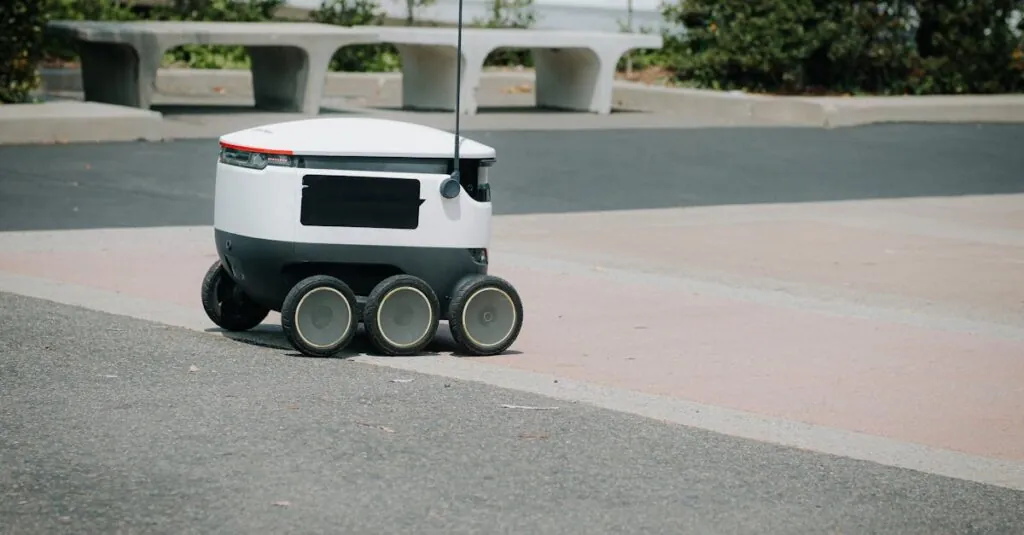Imagine a world where your pizza arrives before you even finish deciding what toppings to order. Autonomous delivery drones are turning that dream into reality, soaring through the skies like high-tech superheroes. These flying wonders are not just a futuristic fantasy; they’re revolutionizing the way we think about delivery services.
With the ability to navigate traffic and avoid pesky parking issues, drones promise to deliver everything from groceries to gadgets in record time. They’re designed to make life easier, faster, and a whole lot cooler. Who wouldn’t want a drone zipping by their window, dropping off a package with a flair that even Santa would envy? As this technology continues to evolve, it’s clear that autonomous delivery drones are not just a trend—they’re the future of convenience.
Table of Contents
ToggleOverview of Autonomous Delivery Drones
Autonomous delivery drones represent a significant advancement in logistics and transportation technology. These unmanned aerial vehicles navigate complex urban environments, significantly reducing delivery times. Businesses increasingly employ them to enhance operational efficiency and customer satisfaction.
Such drones operate through various technologies, including GPS, computer vision, and machine learning algorithms. Real-time data processing allows them to make instant decisions while avoiding obstacles and ensuring safe delivery routes. Research indicates that using drones can reduce delivery costs by as much as 30 percent, providing a competitive edge in the market.
Additionally, regulations play a vital role in the deployment of these drones. Organizations must adhere to safety guidelines set by aviation authorities such as the Federal Aviation Administration (FAA) in the United States. Meeting regulatory requirements ensures that drone operations are safe and sustainable.
Several companies, including Amazon and Wing, are actively testing and implementing drone delivery services. Trials have demonstrated positive results, showcasing the potential for widespread use in urban and rural areas. Customer feedback remains essential as companies refine their delivery processes to meet evolving expectations.
The environmental impact also merits consideration. Drones offer a more sustainable alternative to traditional delivery methods, reducing carbon emissions and traffic congestion. As technology progresses, they could play a crucial role in achieving greener logistics.
Market analysts predict that the autonomous delivery drone industry could reach $29 billion by 2026. This growth signifies a shift toward innovative delivery solutions that align with consumers’ desires for speed and convenience. As adoption increases, autonomous delivery drones are poised to redefine the future of logistics and on-demand services.
Benefits of Autonomous Delivery Drones
Autonomous delivery drones offer significant advantages across various sectors, revolutionizing how goods are transported.
Increased Efficiency
Increased speed is one primary benefit of autonomous drones. These drones can navigate directly to targets without getting stuck in traffic. GPS and computer vision technologies enable quick route adjustments, ensuring timely deliveries. Flexibility allows them to operate in diverse environments, from urban areas to rural settings. Reduced operational time helps businesses meet rising consumer demands efficiently. Enhanced reliability keeps delivery schedules intact, fostering customer trust and satisfaction. Drones can also operate during peak hours, alleviating strain on existing delivery infrastructures.
Cost Reduction
Cost efficiency stands out as a major benefit of using autonomous delivery drones. Research suggests that companies may achieve delivery cost reductions of up to 30 percent. Decreased labor expenses arise from lower reliance on human couriers. Maintenance costs tend to be lower compared to traditional vehicle fleets due to the simplicity of drone mechanisms. Fuel savings result from electric-powered designs, contributing to overall lower operational costs. Additionally, reduced need for parking space cuts overhead expenses, boosting overall profitability. The shift towards drone technology provides companies an opportunity to reallocate budgets optimally.
Challenges Facing Autonomous Delivery Drones
Autonomous delivery drones face significant challenges that could impact their widespread adoption. These obstacles include regulatory hurdles and technical limitations that must be addressed for successful implementation.
Regulatory Hurdles
Regulatory compliance remains a major challenge for autonomous delivery drones. Authorities like the FAA impose strict guidelines to ensure safety and airspace management. Navigating these regulations requires companies to adapt their operations continuously. Current rules often lag behind technological advancements, leading to uncertainty in operational practices. As businesses pilot these drones, they encounter difficulties in obtaining necessary permits, which can delay deployment. Addressing regulatory concerns is crucial for establishing trust among consumers and ensuring the safe integration of drones into existing air traffic systems.
Technical Limitations
Technical limitations present additional hurdles for autonomous delivery drones. These drones rely heavily on GPS, but urban environments pose challenges like signal interference and obstacles. Maintaining consistent connectivity is essential for safe navigation and delivery accuracy. Refined computer vision systems are necessary to detect and avoid obstacles effectively. Battery life also limits flight range, necessitating efficient energy management solutions. Moreover, weather conditions can adversely affect operations, restricting flight capabilities. Innovative solutions and advancements in technology will help mitigate these issues, paving the way for improved performance and reliability in the future.
Leading Companies in Autonomous Delivery Drones
Several prominent companies are pioneering advancements in the autonomous delivery drone sector. Their innovations and strategic initiatives drive the industry forward, making significant impacts on logistics and delivery services.
Amazon
Amazon is a key player in the autonomous delivery drone market. It has launched Prime Air, which aims to deliver packages in 30 minutes or less. The technology combines sophisticated algorithms, computer vision, and advanced sensors. Testing continues in various locations, showing promising results for urban and rural deliveries. Safety remains a primary focus, with compliance to FAA regulations guiding their operational strategies. Environmental considerations also play a role, as Amazon seeks to reduce carbon emissions through drone utilization. By prioritizing customer satisfaction and operational efficiency, Amazon enhances its competitive edge in the e-commerce landscape.
Wing
Wing, a subsidiary of Alphabet, is another leader in drone delivery services. It focuses on making local deliveries faster and more efficient. The company has initiated successful trials in Australia and the United States, where drones have delivered everyday items like food and medicine. Flexibility in operations allows Wing to adapt to different environments and consumer demands. Rigorous safety protocols ensure compliance with airspace regulations, fostering trust among communities. Wing emphasizes sustainability, integrating electric drones to minimize environmental impact. This commitment to innovation and community engagement positions Wing as a formidable contender in the autonomous delivery landscape.
Future Trends in Autonomous Delivery Drones
Emerging technologies will shape the future of autonomous delivery drones significantly. Increased integration of artificial intelligence enhances navigation systems, allowing drones to adapt to dynamic environments. Companies are investing resources in advanced collision avoidance systems to improve safety during deliveries.
Regulatory developments play a crucial role in future operations. With the FAA and other regulatory bodies establishing clearer guidelines, compliance will enable wider acceptance and integration of drones in urban airspace. Collaboration between regulators and businesses is vital for establishing safety protocols and operational standards.
Consumer demand for faster deliveries drives innovation in drone design. Companies aim to reduce delivery times to under 30 minutes, leveraging improved battery technology and more efficient flight paths. Incorporating eco-friendly materials in drone construction supports sustainability, addressing growing environmental concerns.
Research indicates the market for autonomous delivery drones could reach $29 billion by 2026. This growth reflects a shift towards innovative solutions that meet consumer expectations for speed and efficiency. As more businesses adopt drone technology, competitive advantages in cost and service delivery will become essential.
Strategic partnerships between tech companies and logistic providers will enhance capabilities. These collaborations will focus on optimizing routes and ensuring operational efficiency. Enhanced data analytics can further streamline supply chains, supporting timely deliveries and improved customer satisfaction.
Future trends in autonomous delivery drones highlight the importance of technology and regulatory collaboration. As innovation continues, drones are poised to redefine logistics, making delivery systems faster and more sustainable.
The rise of autonomous delivery drones marks a pivotal moment in logistics and transportation. These drones promise to enhance efficiency and reduce costs while addressing growing consumer demands for speed. With advancements in technology and a focus on sustainability, businesses are embracing this innovation to optimize their operations.
As companies navigate regulatory challenges and technical limitations, the future looks bright for drone delivery services. The potential for significant market growth and the ability to redefine delivery systems cannot be overlooked. As the industry evolves, it’s clear that autonomous delivery drones are set to play a crucial role in shaping the future of logistics.






